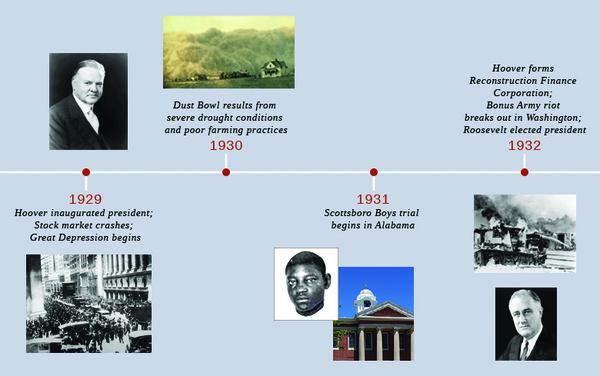| << Chapter < Page | Chapter >> Page > |

Herbert Hoover became president at a time of ongoing prosperity in the country. Americans hoped he would continue to lead the country through still more economic growth, and neither he nor the country was ready for the unraveling that followed. But Hoover’s moderate policies, based upon a strongly held belief in the spirit of American individualism, were not enough to stem the ever-growing problems, and the economy slipped further and further into the Great Depression.
While it is misleading to view the stock market crash of 1929 as the sole cause of the Great Depression, the dramatic events of that October did play a role in the downward spiral of the American economy. The crash, which took place less than a year after Hoover was inaugurated, was the most extreme sign of the economy’s weakness. Multiple factors contributed to the crash, which in turn caused a consumer panic that drove the economy even further downhill, in ways that neither Hoover nor the financial industry was able to restrain. Hoover, like many others at the time, thought and hoped that the country would right itself with limited government intervention. This was not the case, however, and millions of Americans sank into grinding poverty.
Upon his inauguration, President Hoover set forth an agenda that he hoped would continue the “Coolidge prosperity” of the previous administration. While accepting the Republican Party’s presidential nomination in 1928, Hoover commented, “Given the chance to go forward with the policies of the last eight years, we shall soon with the help of God be in sight of the day when poverty will be banished from this nation forever.” In the spirit of normalcy that defined the Republican ascendancy of the 1920s, Hoover planned to immediately overhaul federal regulations with the intention of allowing the nation’s economy to grow unfettered by any controls. The role of the government, he contended, should be to create a partnership with the American people, in which the latter would rise (or fall) on their own merits and abilities. He felt the less government intervention in their lives, the better.
Yet, to listen to Hoover’s later reflections on Franklin Roosevelt’s first term in office, one could easily mistake his vision for America for the one held by his successor. Speaking in 1936 before an audience in Denver, Colorado, he acknowledged that it was always his intent as president to ensure “a nation built of home owners and farm owners. We want to see more and more of them insured against death and accident, unemployment and old age,” he declared. “We want them all secure.” Herbert Hoover, address delivered in Denver, Colorado, 30 October 1936, compiled in Hoover, Addresses Upon the American Road, 1933-1938 (New York, 1938), p. 216. This particular quotation is frequently misidentified as part of Hoover’s inaugural address in 1932. Such humanitarianism was not uncommon to Hoover. Throughout his early career in public service, he was committed to relief for people around the world. In 1900, he coordinated relief efforts for foreign nationals trapped in China during the Boxer Rebellion. At the outset of World War I, he led the food relief effort in Europe, specifically helping millions of Belgians who faced German forces. President Woodrow Wilson subsequently appointed him head of the U.S. Food Administration to coordinate rationing efforts in America as well as to secure essential food items for the Allied forces and citizens in Europe.

Notification Switch
Would you like to follow the 'U.s. history' conversation and receive update notifications?